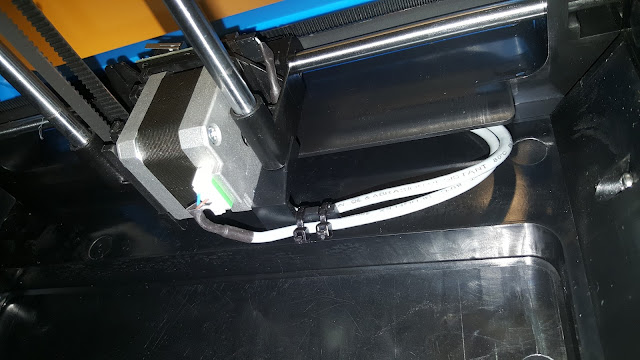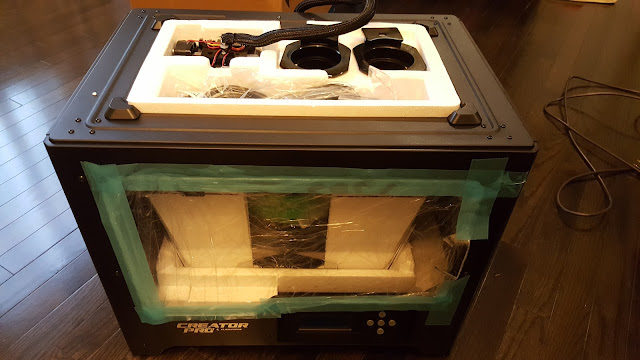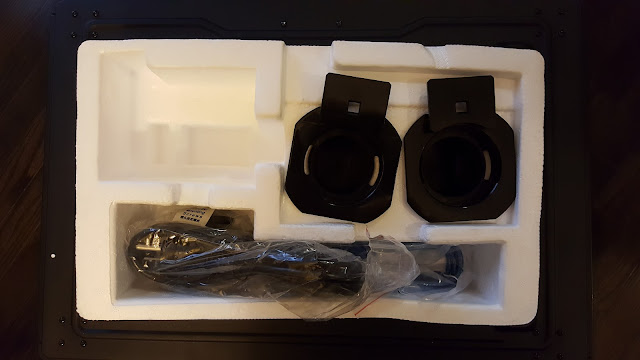Greetings Everyone!
It has been a while since I posted here. I've been reallly busy.
I still like my Finders a lot. After 7 months with a lot of use, I really like:
- the removable build plate: great for getting off those stubborn pieces that stuck too well. Compared to my Flashforge Creator Pro where I had something stick so hard, I ruined the build tak, the Finder has always been good.
- internal filament: this has been great for moving the printer around. I transfer it between home and work so it helps. I also use an external spool holder for bigger, cheaper rolls of filament which is fine too. The internal one has the advantage of stopping your print if/when you run out of filament though.
- level assist: this thing works great for me. I don't have to do the paper test and it's almost always pretty accurate.
But alas, I have hit a point where the Finder's biggest problem has popped up.
I've been printing PLA+ lately at 220C. No problems there. I tried some new colored filament and my prints were coming out weird. Here were my symptoms:
- prints came out structurally weak. As if there was not enough plastic coming out.
- I could hear a "ticking" kind of sound every now and then from the extruder. It sounds like the filament is slipping as it is being fed in
- there were gaps in my printing, it wasn't smooth
I immediately told my vendor (Digitmakers) and he knew right away what the problem was. Of course before I called him I wasted time by taking apart my extruder servo, cleaning the feed heads and trying it again, just to have the same problems.
So Digitmakers told me it was the PTFE tube that had to be changed. This is the plastic tube that goes down the heat break and basically feeds the filament from the extruder servo to the hot end. It can get messed up over time and that results in difficulty feeding the hot end.
Disassembly:
Flashforge made a pretty good video of this which I followed:
The one thing I didn't do was disconnect the "heating part" listed here:
This is where I get really paranoid because you can burn down your house if you screw this up.
This "heating part" includes the part that measures the temperature of your hot end known as the thermocouple. A fire once happened in a 3d printer because the person forgot to secure this and it basically fell out while printing. The 3d printer didn't know what the actual temperature was so it kept increasing the temperature.
So I didn't remove this at all. I kept all the electronics plugged in.
THIS IS WHERE I MADE A MISTAKE
It didn't cost me but I should have done it properly.
I removed the nozzle and the heat radiating tube or nozzle holder (the thing with the fins) with two wrenches. Make sure the wrenches you have are adjustable and fit properly. Don't use a needle nose plyer or something that will scratch things up. Make sure they fit snug on the heater block and the part you are twisting! Remember left-loosey, righty-tighty for directions to turn.
I removed both the heat radiating tube and the brass nozzle without problems but I was lucky. I should have heated it up before removing it. Although dangerous and scary, what could have happened is that the brass nozzle could have snapped inside the heat block and cause some serious problems! It didn't but it happened to someone before.
So I dodged a bullet and got good results.
Here is a photo of the original Finder nozzle and the PTFE tube. As you can see, the tube isn't looking so great. It's burned a bit and clogged up. This explains why extrusion was so difficult. Keep in mind this is not a problem with the Finder, this is something that will happen with all printers using similar set ups!
New Nozzle:
Since I needed a new nozzle, I could have gone for the same brass one, but Digitmakers had Micro Swiss nozzles. I had read that these were good so I went for the Mk10 plated nozzle the was wear resistant and a regular PTFE tube. Maybe next time I'll go for the all-metal one but that's more than twice the cost.
Before putting the nozzle and everything back together, I took the opportunity to clean out one of the drive gears of the extruder. Since it had been fighting to push filament through, it also had been shaving little bits off and reducing the effectiveness of itself. So I took a wire brush to it to clean out the pockets of the gear teeth.
Attaching the Nozzle:
This time I got instructions on how to do this right.
1. Hand tighten the nozzle on
2. Heat the machine up to PLA temp (220C is what I do PLA+ at so I went for that)
3. While it is hot, the metal expands a bit and you can tighten it more with wrenches
Putting everything back is not fun. There's a small set screw that is keeping the entire hot end assembly in place. This thing is easy to have fall out and hard to put back into its hole. After much fussing I got it back in. Make sure that the hot end is put all the way up so that you don't mess up your heights when you are levelling your build plate.
Then test it to make sure that your temperature sensor is working (and not falling out) so your house doesn't go on fire. I set it to pre-heat to 220C.
Finally feed some filament through!
It came out well and things look promising.
I ran a 20mm cube to see how well things thing worked.
And it worked well! Actually as I write this I just finished a 4 hour print and it seems like my printing quality went up a lot! I checked again to make sure the temperature sensor is not falling out and everything is ok and I'm going to print another 4hr job overnight.
What makes me feel better is that the Finder has a baffle on the underside which is surrounding the hotend. So it's unlikely that the thermistor can fall out from vibration. That makes me feel a bit better keeping it unattended. Of course I have a few fire prevention things in place in the washroom which I'll detail later.

















































